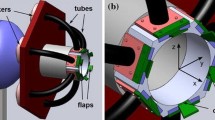Abstract
Miniature electromagnetic flap actuators are developed and mounted on the periphery of the nozzle exit of an axisymmetric jet to induce various flow modes and enhance mixing processes. It is demonstrated that the flap actuators can significantly modify the large-scale vortical structures. In particular, when the flaps are driven in anti-phase on either side of the jet, alternately inclined and bent vortex rings are generated, and the jet bifurcates into two branches. Since the vortex rings are formed at the very vicinity of the nozzle exit, the bifurcation is accomplished as close as x/D=3.






















Similar content being viewed by others
References
Cantwell BJ (1981) Organized motion in turbulent flow. Ann Rev Fluid Mech 13:457–515
Corke TC, Kusek SM (1993) Resonance in axisymmetric jets with controlled helical-mode input. J Fluid Mech 249:307–336
Crow SC, Champagne FH (1971) Orderly structure in jet turbulence. J Fluid Mech 48:547–591
Danaila I, Boersma BJ (2000) Direct numerical simulation of bifurcating jets. Phys Fluids 12:1255–1257
Gad-el-Hak M (1996) Modern developments in flow control. Appl Mech Rev 49:365–379
Gutmark E, Ho CM (1983) Preferred modes and the spreading rates of jets. Phys Fluids 26:2932–2938
Ho CM, Huerre P (1984) Perturbed free shear layers. Ann Rev Fluid Mech 16:365-424
Ho CM, Tai YC (1996) Review: MEMS and its applications for flow control. J Fluids Eng 118:437–447
Ho CM, Tai YC (1998) Micro-electro-mechanical-systems (MEMS) and fluid flows. Ann Rev Fluid Mech 30:579–612
Huang C, Najafi K, Alnajjar E, Christophorou C, Naguib A, Nagib HM (1998) Operation and testing of electrostatic microactuators and micromachined sound detectors for active control of high speed flows. In: Proceedings of the 11th IEEE MEMS Workshop, Heidelberg, pp 81–86
Huerre P, Monkewitz PA (1990) Local and global instabilities in spatially developing flows. Ann Rev Fluid Mech 22:473–537
Jacobson SA, Reynolds WC (1998) Active control of streamwise vortices and streaks in boundary layers. J Fluid Mech 360:179–211
Kasagi N (1998) Progress in direct numerical simulation of turbulent transport and its control. Int J Heat Fluid Flow 19:128–134
Lee M, Reynolds WC (1985) Bifurcating and blooming jets. Report TF-22, Thermosciences Division, Department of Mechanical Engineering, Stanford University, Stanford, CA
Liu C, Tsao T, Tai YC (1995) Out-of-plane permalloy magnetic actuators for delta-wing control. In: Proceeding of the 8th IEEE MEMS Workshop, Amsterdam, pp 7–12
Longmire EK, Duong LH (1996) Bifurcating jets generated with stepped and sawtooth nozzles. Phys Fluids 8:978–992
Mankbadi RR (1992) Dynamics and control of coherent structure in turbulent jets. Appl Mech Rev 45:219–247
McMichael JM (1996) Progress and prospects for active flow control using microfabricated electromechanical systems (MEMS). AIAA Paper 96-0306
Moin P, Bewley T (1994) Feedback control of turbulence. Appl Mech Rev 47:S3–S13
Parekh DE, Leonard A, Reynolds WC (1988) Bifurcating jets at high Reynolds numbers. Report TF-35, Thermosciences Division, Department of Mechanical Engineering, Stanford University, Stanford, CA
Reeder MF, Samimy M (1996) The evolution of a jet with vortex generating tabs: real-time visualization and quantitative measurements. J Fluid Mech 311:73–118
Robinson SK (1991) Coherent motions in the turbulent boundary layer. Ann Rev Fluid Mech 23:601–639
Smith BL, Glezer A (1997) Vectoring and small scale motions effected in free shear flows using synthetic jet actuators. AIAA-paper 97–0213
Suzuki H, Kasagi N, Suzuki Y (1999a) Active control of an axisymmetric jet with an intelligent nozzle. In: Proceeding of the 1st Symposium on Turbulent shear flow phenomema, Santa Barbara, CA, pp 665–670
Suzuki H, Kasagi N, Suzuki Y, Shima H (1999b) Manipulation of a round jet with electromagnetic flap actuators. In: Proceedings of the 12th IEEE MEMS Conference, Orlando, FL, pp 534–540
Wilkinson SP (1989) Interactive wall turbulence control: viscous drag reduction in boundary layers. Prog Astronaut Aeronaut 123:479
Winant CD, Browand FK (1974) Vortex pairing: the mechanism of mixing layer growth at moderate Reynolds number. J Fluid Mech 63:237–255
Yamamoto F, Uemura T, Iguchi T, Morita Z (1991) A binary correlation method using a proximity function for 2-D and 3-D PTV. Exp Num Flow Vis 128:23–28
Zaman KBMQ, Hussain AKMF (1980) Vortex pairing in a circular jet under controlled excitation. Part 1. General jet response. J. Fluid Mech 101:449–491
Zaman KBMQ, Reeder MF, Samimy M (1994) Control of an axisymmetric jet using vortex generators. Phys Fluids 6:778–793
Acknowledgements
The authors gratefully acknowledge Professors H. Miura and I. Shimoyama for their guidance in developing the actuators. We would like to thank Mr. N. Kurimoto for his help in the flap characterization. This work was supported through the Grant-in-Aid for Scientific Research (No. 10355010) by the Ministry of Education, Culture, Sports, Science, and Technology.
Author information
Authors and Affiliations
Corresponding author
Rights and permissions
About this article
Cite this article
Suzuki, H., Kasagi, N. & Suzuki, Y. Active control of an axisymmetric jet with distributed electromagnetic flap actuators. Exp Fluids 36, 498–509 (2004). https://doi.org/10.1007/s00348-003-0756-0
Received:
Accepted:
Published:
Issue Date:
DOI: https://doi.org/10.1007/s00348-003-0756-0




